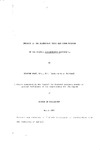IMMUNITY IN THE ALIMENTARY TRACT AND OTHER MUCOSAE OF THE DOGFISH SCYLIORHINUS CANICULA L.
| dc.contributor.author | HART, STEPHEN | |
| dc.contributor.other | School of Biological and Marine Sciences | en_US |
| dc.date.accessioned | 2013-11-19T08:38:44Z | |
| dc.date.available | 2013-11-19T08:38:44Z | |
| dc.date.issued | 1987 | |
| dc.identifier | THESIS | en_US |
| dc.identifier.uri | http://hdl.handle.net/10026.1/2743 | |
| dc.description.abstract |
The gut of Scyliorhinus canicula was examined by light and electron microscopy and was found to harbour a large and heterogeneous leucocyte population which occupied three niches: the lamina propria (intralaminal leucocytes), the epithelium (intra-epithelial leucocytes) and as accumulations of leucocytes. The lamina propria had a mixed population of cells including three granulocyte types, lymphocytes, plasma cells and macrophages. The epithelium contained a similar spectrum of cells, with the exception of plasma cells, which were only detected in the lamina propria. The lamina propria and epithelium of the gall bladder and reproductive tract also contained leucocytes, although not in the same quantities. Accumulations of lymphocytes and macrophages were detected throughout the alimentary tract, but were largest and most predominant in the proximal spiral intestine. Leucocyte populations in all three niches were greatest in the proximal spiral valve and virtually absent from the cardiac stomach. The development of leucocyte population in the spiral intestine was examined. Intralaminal leucocytes were first observed in phase 2 of stage 2 and intra-epithelial leucocytes and lymphoid accumulations in stage 3. The development of the intestinal leucocyte populations occurred after the thymus and kidney and approximately at the same time as the Leydig organ and spleen. Leucocytes were present in all niches of the gut prior to the transition to an exogenous diet. The epithelium of the spiral intestine of the larval stages was shown to phagocytose particulate material (carbon), while the adult intestine demonstrated no such ability. The epithelium of the spiral intestine of both larval and adults was found to absorb soluble protein material (HGG and ferritin). Immunoglobulin was detected in the reproductive tract, spiral intestine, and at levels comparable to that of serum in the bile. Biliary immunoglobulin was compared, on the basis of several criteria, with serum immunoglobulin. Sepcific antibodies were detected in the bile after SRBC’S and Vibrio antigens were intubated into the gut by oral and anal routes and injected directly into the peritoneum. No systemic response, however, was elicited to antigens which had been intubated into the gut by either the oral or anal orifice. | en_US |
| dc.description.sponsorship | University of Salford | en_US |
| dc.language.iso | en | en_US |
| dc.publisher | University of Plymouth | en_US |
| dc.title | IMMUNITY IN THE ALIMENTARY TRACT AND OTHER MUCOSAE OF THE DOGFISH SCYLIORHINUS CANICULA L. | en_US |
| dc.type | Thesis | |
| plymouth.version | Full version | en_US |
| dc.identifier.doi | http://dx.doi.org/10.24382/4986 | |
| dc.identifier.doi | http://dx.doi.org/10.24382/4986 |
Files in this item
This item appears in the following Collection(s)
-
01 Research Theses Main Collection
Research Theses Main


